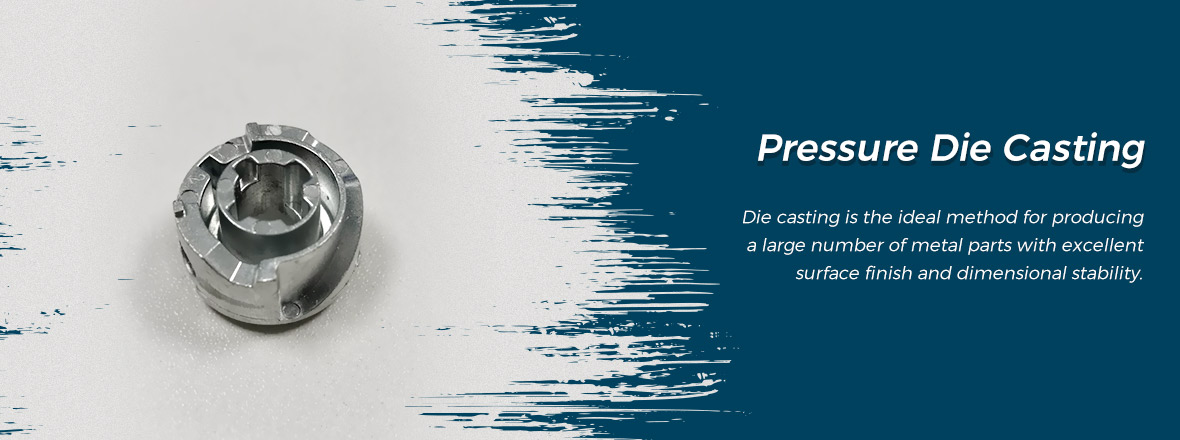Лиття під тиском
Лиття під тиском - це процес лиття під тиском. Характеризується поданням високого тиску на розплавлений метал за допомогою порожнини форми. Форми зазвичай виготовляються з міцніших сплавів - процес, подібний до лиття під тиском. Більшість виливків під тиском беззалізні, такі як цинк, мідь, алюміній, магній, свинець, олово та свинцево-олов'яні сплави та їх сплави. Залежно від типу лиття під тиском, потрібна машина для лиття під тиском холодної камери або машина для лиття під тиском з гарячою камерою.
Лиття під тиском - це спеціальний метод лиття, який швидко розвивався в сучасних технологіях обробки металів з незначним різанням або без нього. Це процес заповнення розплавленої форми під високим тиском та високою швидкістю, кристалізація та затвердіння під високим тиском для формування виливків. Високий тиск і висока швидкість - основні особливості лиття під тиском. Зазвичай використовується тиск становить десятки МПа, швидкість заповнення (швидкість у затворі) становить від 16 до 80 м / с, а час заповнення порожнини прес-форми металевою рідиною надзвичайно короткий, приблизно від 0,01 до 0,2 секунди.
Переваги лиття під тиском під тиском
Лиття під тиском є ідеальним методом для виготовлення великої кількості металевих деталей з чудовою поверхневою обробкою та стабільністю розмірів.
Виробничий цикл HPDC включає:
1. Metering of metal into the shot sleeve.
2. Plunger movement.
3. Rapid die filling. The steel dies, typically 200-300°C, dissipates the latent heat.
4. During solidification, the casting is pressurized hydraulically by the plunger to feed the solidification shrinkage. Locking forces up to 4000 tons are commercially available to withstand the large pressures
5. The die is opened.
6. The casting is then ejected. The hydraulic energy is provided by a computerized system that permits control of metal position, velocity and plunger acceleration to optimize the flow and the pressure during filling and solidification.
Application of Pressure Die Casting
The number of parts varies from 50 or 100 of the prototype parts to thousands of mass production requirements-all of which will be produced in a careful and precise way that we apply to all projects.
- Automotive parts like wheels, blocks, cylinder heads, manifolds etc.
- Aerospace castings.
- Electric motor housings.
- Kitchen ware such as pressure cooker.
- Cabinets for the electronics industry.
- General hardware appliances, pump parts, plumbing parts.
Essai's die casting equipment has the ability to process internal molds and can produce molds with a weight of 2.5KGS and a size of up to 500x500x250mm. We have 10 die-casting machines with clamping forces ranging from 80T to 630T. The commonly used casting materials are aluminum (usually ADC10 / 12 and A380) and zinc (3 # / 5 #). Castings can also be subjected to a large number of second processes in Essai's own processing facilities, as well as various cosmetic processes including powder coating, spray coating, anodizing, polishing, and electroplating.
1. High pressure dies casting can be divided into "cold-chamber" and "hot-chamber" processes.
2. In the cold-chamber process, molten metal is metered into a cold chamber for each machine cycle (or shot).
3. The molten metal is then forced by a single plunger through a narrow feeder channel (or gate), into the die cavity itself, by the application of pressures from 7 to 207 MPa.
4. The metal solidifies rapidly because the die is water-cooled within a fraction of a second.
5. Upon solidification, the dies are opened and the casting is removed using ejector pins.
6. Most of the castings will have flash where the two die halves come together. This is usually removed in a trimming die.
7. The high cost of dies (up to £250,000) and the capital cost of machines (£175,000–£350,000) limit this process to the high volume production of components.
8. Лиття під тиском у гарячих камерах обмежується сплавами магнію та цинку з низькою температурою плавлення, де забруднення залізом буде менш значним. Рукав з гусячої шиї занурюється в розігрітий горщик з розплавленим розплавом. Плунжер опускається вниз і змушує розплавлений метал в матрицю. Коли поршень втягується, циліндр наповнюється металом.
1. High pressure dies casting is restricted to the lower melting point alloys.
2. The bulk of die casting is carried out in zinc-, magnesium- and aluminum-based alloys.
3. The most popular zinc-based alloys (known as Mazak) contain 3.8–4.3% aluminum and 0.10–1.25 wt% copper, with tensile strengths of 293–355 MPa, and elongations of 3–4%. Zinc alloys have a higher impact strength than die-cast aluminum alloys.
4. There is six main aluminum die casting alloys used in the UK. All contain 4–13 wt% silicon, which is used to promote good castability. The most common alloy is LM6-M (BS 1490), which contains 10–13% silicon, and has a tensile strength of 280 MPa and an elongation of 2–5%.
5. The strict melting practice is required with magnesium-based alloys, which are mainly used on hot-chamber machines. The most popular alloy contains 9–10% aluminum and 1% zinc, achieves a tensile strength of 215 MPa and an elongation of 2%.
6. The degree of retained porosity in the die casting affects the properties of the product.
Ласкаво просимо розпочати свій бізнес зараз!
Зв'яжіться з нами




